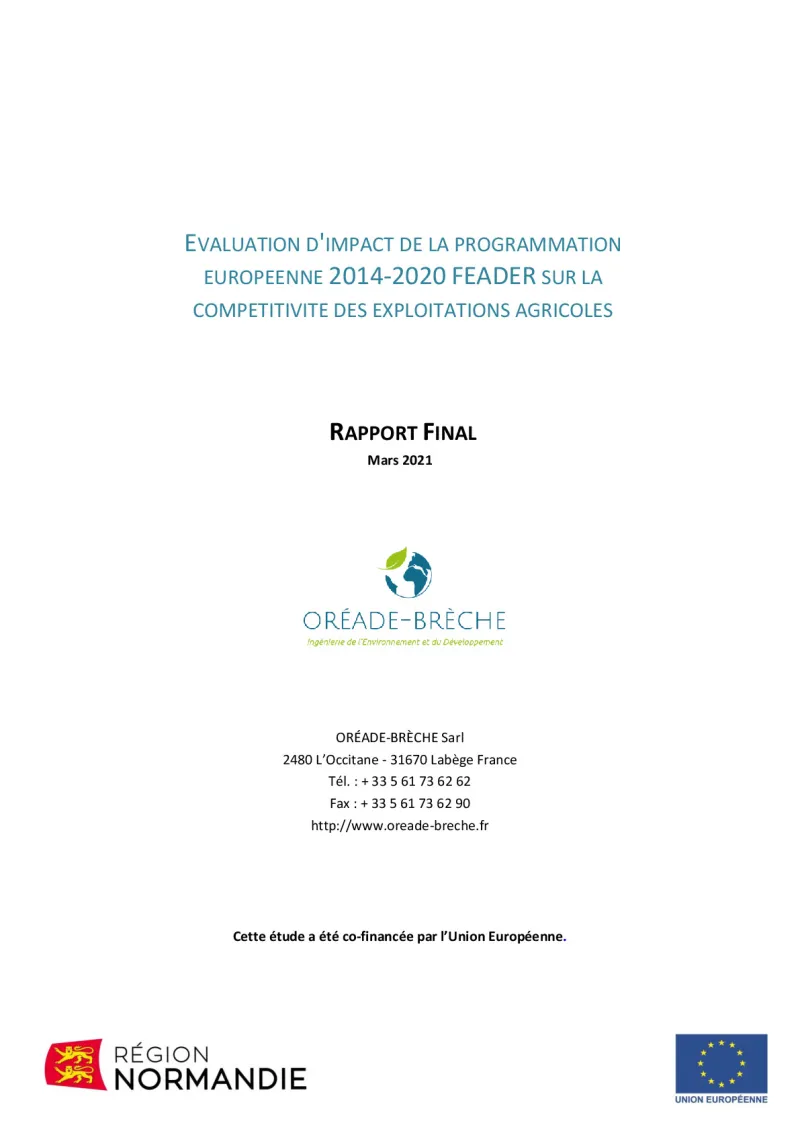Bewertung der Auswirkungen des Programms zur Entwicklung des ländlichen Raums auf die Wettbewerbsfähigkeit landwirtschaftlicher Betriebe
- Bewertung
- Wachstum, Beschäftigung und Gleichstellung in ländlichen Gebieten
- Klima und Klimawandel
- Generationswechsel
- Bewertung
In diesem abschließenden Bewertungsbericht wird die Relevanz der Maßnahmen der Entwicklungsprogramme für den ländlichen Raum (EPLR) und ihre Wirksamkeit bei der Verbesserung der Wettbewerbsfähigkeit und Leistung der landwirtschaftlichen Betriebe in der Normandie in verschiedenen landwirtschaftlichen Sektoren untersucht.
- France
- 2014-2022
- Environmental impacts


Die Normandie ist eine Region, die für ihre landwirtschaftliche Produktion bekannt ist. Im Jahr 2016 gab es hier etwa 31.070 Betriebe, was etwas mehr als 7 % der französischen Betriebe entspricht.
Die Viehzucht, einschließlich der Milchviehhaltung, ist der wichtigste landwirtschaftliche Sektor in der Region (etwa 30 % der Betriebe). Sie ist mit typischen Produkten wie Butter, Sahne und Kuhmilchkäse verbunden, bei denen die Normandie die führende Erzeugerregion ist.
Die Normandien-weite harmonisierte Zuweisung für Junglandwirte (Maßnahme 6.1.1) ist eines der Vorzeigeprogramme zur Förderung der Niederlassung von Junglandwirten. Diese finanzielle Unterstützung ist an die Fertigstellung eines Unternehmensplans gebunden und wird nach bestimmten Kriterien (z. B. benachteiligte Gebiete, nicht familiäre Einrichtungen, agroökologische Projekte usw.) angepasst.
Die Bewertung wurde im Jahr 2020 durchgeführt, um die Auswirkungen der Maßnahmen des Programs zur Entwicklung des ländlichen Raums (EPLR) auf die Wettbewerbsfähigkeit des Agrarsektors zu untersuchen. Die Ergebnisse wurden in den Diskussionen zur Ausarbeitung des nächsten EPLR verwendet.
Die Bewertung konzentriert sich auf die Wirksamkeit, Relevanz, Effizienz und Kohärenz der folgenden EPLR-Maßnahmen:
- Maßnahmen 3.1 und 3.2, die die Teilnahme an Qualitätsregelungen und die Information/Förderung von Produkten, die unter diese Regelungen fallen, unterstützen.
- Maßnahme 4.1.1, die Investitionen unterstützt.
- Maßnahmen 4.2.1 und 4.2.2, die Investitionen in die Entwicklung der Verarbeitung in landwirtschaftlichen Betrieben und die Verarbeitung/Vermarktung in kleinen Unternehmen der Agrarlebensmittelindustrie unterstützen.
- Maßnahme 6.1.1, die die Gründung und Übernahme von landwirtschaftlichen Betrieben unterstützt.
Die Bewertung zieht eine Bilanz der Umsetzung dieser Maßnahmen und ihrer Auswirkungen auf die Wettbewerbsfähigkeit der landwirtschaftlichen Betriebe in der Normandie. Sie untersucht die wirtschaftlichen, sozialen und ökologischen Auswirkungen sowie ihren Beitrag zur Innovation. Diese eingehende Studie wurde auch genutzt, um Empfehlungen zur Verbesserung der Wirkung dieser Maßnahmen im nächsten Programmplanungszeitraum zu erarbeiten.
Die Auswirkungen auf andere Querschnittsthemen werden ebenfalls berücksichtigt, wie z. B. Generationswechsel, Beschäftigung, Widerstandsfähigkeit der Landwirtschaft gegenüber Klimarisiken und der Weg zum ökologischen Wandel.
Schließlich wurde bei dieser Bewertung die Kohärenz mit anderen Zielen des EPLR der Normandie untersucht, wie z. B. Innovation, agroökologischer Wandel, Tierwohlbefinden und Beschäftigung.
Die Bewertung stützte sich hauptsächlich auf eine gründliche Analyse der Umsetzungsdaten, um die Akzeptanz der EPLR-Maßnahmen nach Betriebstypen zu bewerten.
Die Bewertung der Auswirkungen der Maßnahmen des EPLR auf die Rentabilität landwirtschaftlicher Betriebe und die Wettbewerbsfähigkeit aller Arten von Landwirtschaft in der Normandie während des Programmplanungszeitraums 2014–2022 war größtenteils qualitativer Natur. Es wurden Daten durch ausführliche Interviews mit Institutionen, die an der Umsetzung der EPLR-Maßnahmen beteiligt waren, und Interessenvertretern des Agrarsektors erhoben. Darüber hinaus wurden 31 ausführliche Interviews mit Begünstigten der Programme aus der gesamten Region und den wichtigsten begünstigten Sektoren durchgeführt. Die in diesen Interviews gesammelten Informationen waren nützlich, um die Stärken und Schwächen der Programme besser zu verstehen.
Die Bewertung basiert auch auf einer Literaturrecherche, einer Online-Umfrage unter Begünstigten und einem partizipativen Workshop mit Landwirten. Insgesamt wurden 1.788 Landwirte, die von den Programmen profitierten, zur Teilnahme an der Umfrage gebeten. Davon antworteten 229, was einer Beteiligung von rund 13 % entspricht.
Die Online-Umfragen lieferten genaue Informationen über die im Rahmen der EPLR-Maßnahmen getätigten Investitionen. Die Repräsentativität der erzielten Ergebnisse ist jedoch mit Vorsicht zu betrachten.
Die Bewertung kommt zu dem Schluss, dass die Landwirte, insbesondere die Milch- und Fleischproduzenten, die EPLR-Maßnahmen schätzten und dass sie ihren Bedürfnissen entsprachen, indem sie die für die Durchführung von Projekten erforderlichen Investitionen erleichterten. Das sehr selektive Antragsverfahren der Landwirte begünstigte jedoch ehrgeizige Projekte und ließ weniger effiziente Betriebe mit geringerer Investitionskapazität, die keine Großprojekte durchführen können, außen vor. In der Bewertung wurde empfohlen, Auswahlkriterien auf der Grundlage der Fläche und/oder der wirtschaftlichen Größe einzuführen, um ihre Auswahl zu fördern.
Die Unterstützung in der Startphase wurde ebenfalls geschätzt, insbesondere von neuen Junglandwirten, deren Familien nicht im Agrarsektor tätig sind. Die befragten Vertreter der Landwirte lobten die Relevanz des Programms, das die Rentabilität der unterstützten Betriebe stärkte.
Die Umweltleistung der Projekte hätte stärker berücksichtigt werden können. Die Maßnahmen des EPLR begünstigten Landwirte, die sich bereits in einem ökologischen Übergangsprozess befanden, manchmal zum Nachteil derer, die Schwierigkeiten hatten, überhaupt erst anzufangen. Eine Lösung könnte darin bestehen, spezifische Einheitsbeträge zur Förderung von Umweltprojekten einzuführen, anstatt Auswahlkriterien zu verwenden, um „konventionellen“ Landwirten die Teilnahme am Programm zu ermöglichen und durch einen höheren Finanzierungssatz einen starken Anreiz für Umweltprojekte zu bieten.
Author(s)
Oreade-Brèche